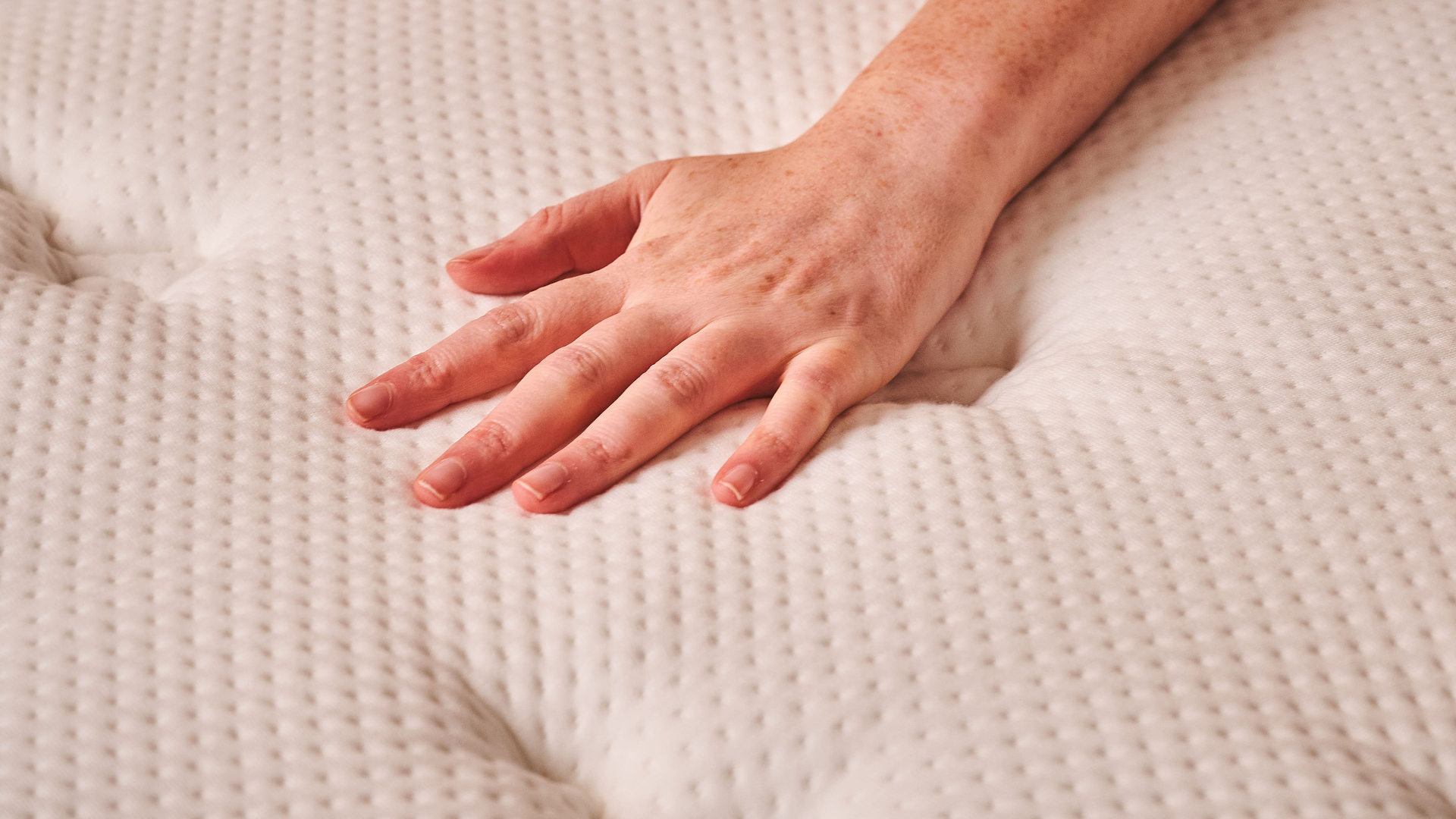How to choose a mattress — tips from a Certified Sleep Coach

Wondering how to choose a mattress when there are so many different types available online and in store? It can seem confusing at first, but as a mattress editor and Certified Sleep Science Coach, I’m here to tell you that picking a comfy new bed doesn’t have to be difficult. In fact, answering a few key questions is all it takes to kick-start your mattress-buying journey.
When choosing a mattress, my number one rule is to buy one that comes with a sleep trial. A sleep trial allows you to return the mattress within the trial period for a refund or exchange if it isn’t right for you. Every one of this year's best mattresses come with a sleep trial, ranging from 90 nights to 365 days, depending on the brand.
Trials are particularly important when buying online as you won’t have a chance to get ‘hands-on’ with a mattress beforehand. They also give you time to adjust to the new mattress, much longer than the 10 minutes you might spend lying on it in-store. Here’s my expert advice on how to choose a mattress in the mattress sales.
Mattress types explained
There are six main types of mattress for you to choose from, but not all of them will suit you for reasons I'll explore in this article.
The following mattress types are widely available to buy online and in store, and knowing the basics about each one will make your shopping experience so much easier:
Hybrid – this type of mattress is made from foam and either coils or springs. The foam is part of the comfort system and the coils are part of the support system. Hybrids are bouncier than all-foam mattresses (and more expensive), and they sleep cooler thanks to better airflow through the coils / springs. The best hybrid mattress right now is the Saatva Classic, a luxury innerspring hybrid that delivers a hotel bed feel at home (read our Saatva Classic mattress review).

Foam – this mattress type contains just foam, without a coil or spring in sight. It’s a great choice if you love mattresses that hug the body, but all-foam beds do retain more warmth than other types, so tread carefully if you’re prone to overheating. The best memory foam mattresses offer superb pressure relief and motion isolation – they’re excellent at dampening the movements of your partner so your sleep isn't disrupted.
Get instant access to breaking news, the hottest reviews, great deals and helpful tips.
Innerspring – often mistaken for a hybrid, this traditional mattress type has a coil-based system to offer support. We don’t recommend straight innersprings if you need lots of pressure relief or motion isolation, but some people still prefer them because they’re bouncy and affordable.
Latex – not to be mistaken for latex hybrids, pure latex mattresses are constructed with layers made entirely of latex. Most use natural or organic latex, such as Talalay. Latex are the longest-lasting mattresses, with excellent pressure relief and natural cooling power. That comes at a price though, making them a luxury mattress purchase.
Air mattress – here the support core is made from air chambers, which are inflated via pump (or app or remote if there’s smart functionality). Air mattresses are a good choice if you want to control the firmness of your mattress and aren’t sure what type of feel you like best. To be clear, these are very different to air beds for guests and much more expensive.
Smart mattress – these are app-controlled beds that track your sleep duration and quality, as well as suggesting possible improvements. I tend to take most sleep tracking results with a pinch of salt as these are not conducted in lab environments with proper sleep testing protocol. However, the data can be interesting to give you a general overview of what's happening with your sleep. Smart mattresses and smart beds often offer custom cooling and heating (for each side individually), plus custom firmness for you and your partner.
How to choose a mattress firmness level
When choosing a mattress firmness, I recommend letting your sleep position and body weight do most of the talking. Both of those factors have a big impact on the firmness you’d find most comfortable. Here’s a guide to the different firmness levels and who they suit most:
| Firmness rating: | Feel: | Who should choose it: |
| 1-2 | Pillow soft | Side sleepers weighing under 130lbs |
| 3 | Soft | Side sleepers weighing under 130lbs |
| 4 | Medium-soft | Side sleepers of light to average weight who love soft beds |
| 5 | Medium | Side sleepers of any weight; back and stomach sleepers weighing 130lbs or less |
| 6-7 | Medium-firm | Back, stomach and side sleepers of average weight (130-230lbs); sleepers with back pain |
| 8-9 | Firm | Heavier bodies weighing over 240lbs; sleepers with back pain who like firmer mattresses |
| 10 | Hard firm | We don't recommend this level of firmness unless it's advised by your health practionier |
How to choose a mattress thickness
Mattress thickness refers to how tall a mattress measures from the base to the top. It can affect the overall feel of the mattress and, as with firmness, body type and sleep position are key to choosing the right height. Your bed frame and whether you share a bed are also important factors. Here's a quick breakdown of mattress height:
| Type: | Height range: | Best for: |
| Low profile | 2 to 5 inches | Babies and infants, foldaway beds, |
| Slim | 5 to 8 inches | Kids, those with limited mobility, guest rooms |
| Standard | 8 to 12 inches | Most body types and sleep styles |
| Thick / Deep | 12 to 16 inches | Plus-sized sleepers, side sleepers, bed sharers. Not suitable for some adjustable bed bases |
| Extra thick / Extra deep | 16 inches or more | Plus-sized adults, families, large bedrooms. Not suitable for most adjustable bed bases |
How to choose a mattress for your sleep position
The way you sleep is a big factor in what type of mattress you should choose. I’ll be speaking in broad terms in this article, but here’s how to choose a mattress according to your sleeping position:
Side sleepers – Pick a mattress that offers constant pressure relief around your hips, shoulders and knees. Those pressure points will be impacted the most by your mattress, so softness and contouring is needed here to help you sleep comfortably. A soft to medium-firm mattress is the best choice for side sleeping.

Back sleepers – Choose a mattress that has ample support layers and a focus on lumbar support. You want to remain on top of the mattress and not sink down into it, as sinkage could cause your back to dip leading to pain over the long-term. You might also enjoy a Pillow-top or Euro top to add an instant touch of softness without having anything too contouring. Medium-firm is ideal for most people, with heavier persons leaning towards firm back sleeping mattresses.
Stomach sleepers – Like back sleepers, you should choose a mattress that keeps you on top of the sleep surface to keep your spine in healthy alignment. Any dip in your lower back will create pain that will travel up to your neck. Again, medium-firm mattresses are good for stomach sleepers, but softer beds are generally a no-no for this position.
How to choose a mattress for your body type
In addition to your sleeping position, your body weight is an important consideration when choosing a mattress. Why? Because lighter bodies don't sink into a mattress as much as heavier bodies, and that affects the way the spine is aligned, how pressure points are relieved, how motion is isolated and other key factors. Here's what you need to know about mattresses and body weights:
People weighing under 130lbs – choose a softer mattress with decent contouring, especially if you sleep on your side as you want to cradle your shoulders, hips and knees to reduce pressure build up. I recommend a memory foam mattress or a soft to medium-soft hybrid as the best option for you.
People who weigh 130lbs to 230lbs – you have a greater choice available to you, but I recommend a medium-soft mattress if you're closer to 130lbs regardless of sleep position, or a medium-firm if you're closer to 230lbs and sleep on your stomach or back.
People who weigh over 230lbs – choose a firm mattress with plenty of support to stop you from sinking further into the mattress, where your spine will dip out of alignment, causing back and neck pain. A firmer bed will also be easier for you to move around on, with mattresses for heavy people designed using durable materials to help them last longer under a higher body weight.
How much do mattresses cost by size?
The cost of a mattress is affected by the materials it is made from, the quality of those materials (especially if any are certified organic), where it's made and how many imported elements are involved, and whether the mattress is sold online or in store. Shipping can also impact cost, with boxed beds tending to be cheaper than traditional, flat-shipped beds that arrive via White Glove Delivery.
Here's how much a mattress costs, on average, this year:
| Type | Average price for a queen | Average price for a king |
| Memory foam | $699 - $1,099 | $849 - $1,299 |
| Hybrid | $899 - $1,599 | $999 - $1,799 |
| Latex | $1,599 - $2,099 | $1,699 - $2,399 |
| Innerspring | $399 - $599 | $649 - $799 |
| Air mattress | $1,899 - $2,400 | $2,000 - $2,800 |
| Smart mattress | $2,200 - $3,199 | $3,399 - $4,699 |
What to avoid when buying a mattress
It's easy to get carried away when you're mattress shopping – all these beds promising you the best sleep of your life are very tempting. I've helped countless people choose a good mattress for their sleep needs, body and budget, and over the years I've come up with a list of things to avoid when choosing a mattress.
Not doing the following will ensure that you make a good choice based on your needs, rather than getting swayed by marketing language:

Tip 1: Choose a mattress that comes on a sleep trial – this is my number one golden rule, as a sleep trial enables you to try the mattress at home before fully committing. Yes you still have to pay for the bed upfront, but if you change your mind about it during the trial, you can more easily return it for an exchange or refund. Just make sure you take care of the mattress during the trial period (and beyond) – I suggest covering it with the best mattress protector you can afford, as you won't be able to return the bed if its damaged or stained.
Tip 2: Never buy based on discount alone. There are huge mattress sales most months, so you can regularly get a top-rated mattress in a box for up to 50% off. But a super-cheap price shouldn't be your only deciding factor; remember to think about your sleeping position, body type and who you're sharing a bed with too.
Tip 3: If buying online, make sure that you open the boxed mattress as soon as it arrives. Leaving it in the box for longer than the manufacturer recommends may compromise the materials within the mattress and reduce its ability to expand properly to provide the comfort and support it is meant to. And while it's tempting to sleep on a mattress while it's expanding, this can also compromise its shape and performance.
What to remember when choosing a mattress
Choosing a mattress should be a fun experience, and the more knowledge you arm yourself with ahead of shopping, the easier it is to find the right mattress for you.
Make sure you know which mattress size suits you best (standard sizes in the US include twin, twin XL, full, queen, king and Cal king, and in the UK you can find single, double, king and super-king). Generally speaking, queen size (US) and king size (UK) mattresses suit most couples, but get clear on mattress dimensions before you buy and make sure the mattress you're considering will fit your existing bed frame – unless you're sizing up or down on purpose.
Understand the different types of mattress and how they each affect your physical comfort and the quality of your sleep. For example, memory foam is a good choice for people needing deep pressure relief and body-hugging comfort but it can trap heat and might be too warm for hot sleepers.
Only buy a mattress that comes on a trial period and that has a clear returns policy. Most sleep brands offer free shipping, but a few, such as Saatva, charge an admin fee to cover returns and exchanges.
When to buy a mattress
Wondering when is the best times to buy a mattress? There are five major bed sales throughout the year, and these tend to offer the lowest MSRPs and the biggest discounts on a wide range of mattresses. In order of the biggest savings, the sales to look out for are:
- Black Friday – the last Friday in November (see our Black Friday mattress deals guide)
- Cyber Monday – the Monday directly after Black Friday (see our Cyber Monday mattress sales guide)
- Presidents' Day – the third Monday in February (see our Presidents' Day mattress sales guide)
- Memorial Day – the last Monday of May (see our Memorial Day mattress sales guide)
- Labor Day – the first Monday in September (see our Labor Day mattress sales guide)
Of these, Black Friday is traditionally the biggest sale day of the year, while Memorial Day is a good chance to save before the summer (when prices typically rise slightly). Popular sleep brands such as Saatva, Helix, and Brooklyn Bedding tend to launch their biggest savings over these periods.
However, some brands run evergreen sales. These year-round deals might fluctuate slightly month by month, but for the most part, you’re getting the same price whenever you shop. Nectar, DreamCloud, and WinkBed run these types of sales.
Today's best prices on popular mattresses

Claire is a Certified Sleep Science Coach and the Managing Editor of Sleep at Tom's Guide. She curates our mattress guides and oversees our rigorous mattress testing procedures. Claire has over 16 years' product review experience and is connected to a wealth of globally renowned sleep experts including mattress designers and buyers, neuroscientists, and doctors of sleep medicine. As the Managing Editor of our Sleep and Mattress Team, Claire is responsible for all mattress and sleep content published on Tom’s Guide and is our expert on Saatva, DreamCloud, and Nectar mattresses. Claire is also certified to advise people on how to choose a mattress that suits their needs and budget, as well as helping them to create a nighttime routine and bedroom environment that helps them sleep better.
